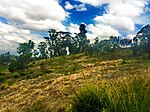Prospect dolerite intrusion

The Prospect dolerite intrusion, or Prospect intrusion, is a Jurassic picrite or dolerite laccolith that is situated in Sydney, New South Wales, Australia. Lying in the heart of Cumberland Plain, in the suburb of Pemulwuy (previously Greystanes), the intrusion is Sydney's largest body of igneous rock, rising to a height of 117 metres (384 ft) above sea level. The site is formed by an intrusion of dolerite rock into Ashfield Shale. At least seven different rock types occur in the intrusion. The site was formed from around 200 million years ago when volcanic material (hot magmatic fluids) from the Earth's upper mantle moved upwards and then sideways, which produced many different minerals in the upper part. Also known as Prospect Quarry, the eroded residue of the volcanic core became a quarry of the basalt plug that was carried out from 1820s until the late 2000s, where it contributed most of the crushed rock that were used for building construction and roads in the Sydney area. The intrusion comprises: prospect dolerite and prospect teschenite, in addition to an abundance of coarse grained picrite, olivine and its prehnite specimens.
Excerpt from the Wikipedia article Prospect dolerite intrusion (License: CC BY-SA 3.0, Authors, Images).Prospect dolerite intrusion
Basalt Road, Sydney Pemulwuy
Geographical coordinates (GPS) Address Nearby Places Show on map
Geographical coordinates (GPS)
| Latitude | Longitude |
|---|---|
| N -33.825 ° | E 150.91805555556 ° |
Address
Basalt Road
Basalt Road
2145 Sydney, Pemulwuy
New South Wales, Australia
Open on Google Maps









